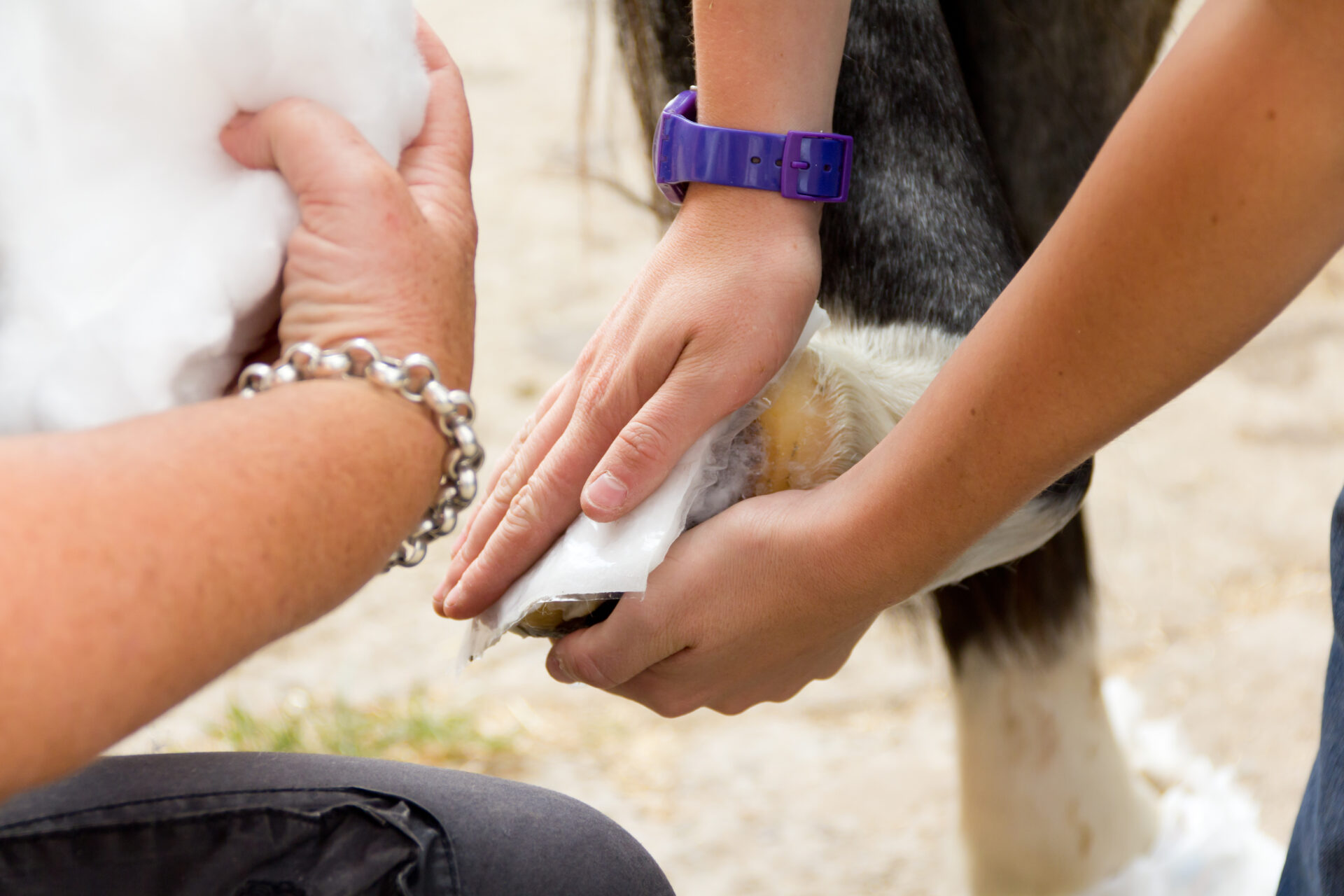We bet there isn’t a single horse out there who hasn’t gotten themselves into one sort of scrape or another. Whilst we’d always recommend having illness or injury checked out by the professionals, there are often things that owners can do to ease suffering or prevent worsening of a situation while veterinary attention is sought. Be it a cut limb, a swollen leg or some sort of illness, we’ve got some helpful first aid advice that could make all the difference to your horse.
Safety first
Horses are a prey species, and they behave as such; they are easily spooked by seemingly silly things. If your horse has injured themselves after a scare, getting up close may only serve to put you in harm’s way. In these situations, prioritise removing the cause of the panic and wait for them to calm down before approaching if at all possible. Next, take a moment to check the environment and ask yourself “are we in a safe space?”. If the answer is “no!” then attempt to move to one. Small stables for example, can pose a danger when examining painful horses, particularly where the pain is at the kicking end.
Call the vet
In most cases it is advisable to phone for veterinary advice. This won’t necessarily result in a visit however you are likely to obtain some nuggets of wisdom just by chatting things through. Be armed with some basic information before phoning them, such as the position and severity of any wounds, information on blood loss should there be any, your horse’s general demeanour, and perhaps even their pulse rate, respiration rate and body temperature, depending on the problem.
First aid for wounds
Once again, we recommend phoning the vet regarding any wound. Wounds which are likely to be of a more serious nature include those that are deeper than the thickness of the skin, those situated over a joint, those that are large in size, are dirty, are bleeding profusely, or are associated with lameness.
Action to be taken
- Stop bleeding – apply appropriate pressure to the wound with a clean wadding type dressing and bandage. Where a foreign body (such a stick or a piece of metal) has perforated the skin and remains within the wound, leave it in situ. Removing it may worsen bleeding. Instead, create a doughnut of wadding around the item and apply pressure in this way instead. Call the vet immediately for advice. Never leave pressure bandages on indefinitely, there are a whole host of issues that can arise from tight bandages such as pressure sores, loss of hair and even tendon damage. Wadding/padding is yours (and your horse’s) friend here, applying plenty beneath a bandage can prevent the above-mentioned problems.
- Prevent infection – horses by nature reside in ‘dirty’ environments and tend to cut themselves on dirty things. Infection can take hold quickly and this is where a stitch in time can save nine. Use clean, warm water and clean swabs for wiping any wound, discarding each swab after only one use. Antibacterial skin solutions such as Hibiscrub can be very helpful for preventing infection in these situations; always follow written guidance of how much to use and never use it neat, always dilute by the right amount (usually 1:20).
- Do not contaminate the wound – avoid using wound powders or creams on ANY wound that breaks the skin. These powders and potions may kill bacteria, but they also damage the cells at the skin edges, making it harder for the wound to heal itself.
- Cover – applying a light dressing to keep a wound clean allows some thinking time and/or time for the vet to attend without further contamination of the wound. Wounds to the body might be best covered with an adhesive dressing where the limbs can be gently bandaged. Beware that certain types of bandage can easily tighten, causing the limb to swell if care isn’t taken. Once again, padding will help prevent this from happening.
Swellings
The body’s inflammatory response to injury is a complex one. On one hand, helpful blood components such as white blood cells are rushed to the area in an attempt to reduce threat of infection from bacteria. On the other hand, inflammation can cause damage and pain. Reducing inflammation is generally the goal in response to injury and one way to achieve this is by cold hosing. 15 minutes of a constant stream of cold water over an area can do wonders to soothe and reduce swelling. Call for advice from the vet before cold hosing near wounds. It is easy to force water under the skin which isn’t helpful for wound healing.
Eye problems
If you suspect your horses has hurt or damaged their eye, always contact the vet; eyes are important things, and easily damaged. Take care when removing foreign objects from eyes. Where the eyeball itself has been punctured, contact your vet for advice as an emergency.
Some vital signs
When phoning the vet about a sick horse, there are some snippets of information that can greatly aid them in determining whether the situation is an emergency one. Here’s how to assess pulse, respiration and temperature:
- Pulse – using two flat fingers, feel for the facial artery beneath the lower jaw (it feels like a pulsing pencil, travelling diagonally over the underside of the lower jawbone). Once located, count the number of pulses over one minute. If this is difficult to achieve, try counting over 20 seconds and multiplying the result by three. The normal pulse rate for a horse is about 30 to 40 beats per minute.
- Respiration – first observe the horse’s respiration for signs of effort. Other than after exercise, respiration should look smooth, easy and rhythmic. Next count the number of breaths taken over one minute as described above. The normal respiration rate for a horse is 6 to 18 breaths per minute.
- Temperature – secure the horse (ideally ask someone to hold them for you) for your safety and stand to the side of their rear end. Insert a pre-lubricated thermometer into the rectum and angle it towards the rectal wall, gently. Await the beep from the thermometer and read the result. Normal body temperature for a horse is between 37.2°C and 38.3°C.
First aid kit
Having a few useful basics to hand in an emergency can really make things go better for your horse. Here are our suggestions for a well-stocked first aid kit:
- Melolin dressings
- Cotton wool
- Synthetic padding bandages such as Soffban
- Cohesive bandages such as Co Flex
- Poultice material
- Digital thermometer
- Antibacterial solution such as Hibiscrub
- Hydrogel
- Scissors
- Tweezers
- A torch
Equine first aid is a complex topic, and we hope you feel somewhat more informed having read our article. Having the correct tools to hand is vital, which is why we have collated a number of first aid items within a practical, purpose designed first aid kit bag for your convenience. See our Equine First Aid Kit for more details or browse our medical supplies for individual items.






